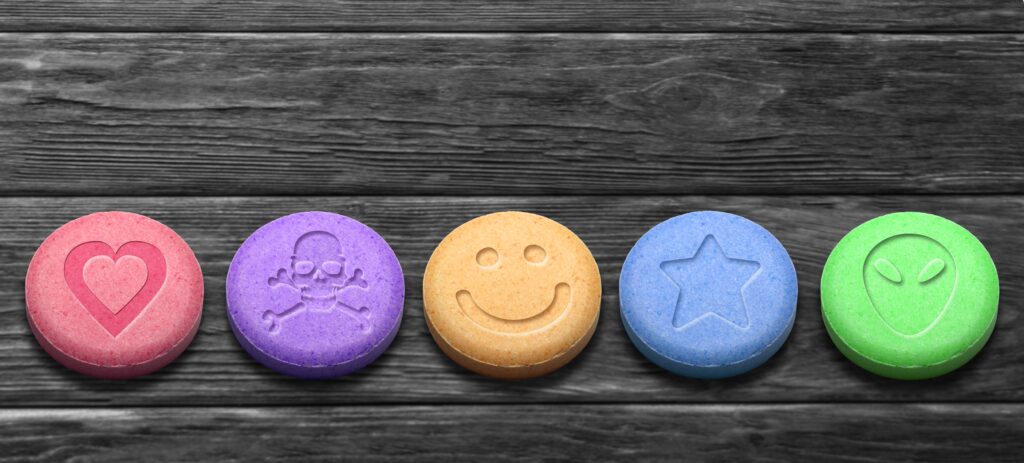Sally (MDA) and Molly (MDMA) are synthetic party drugs belonging to both the amphetamine (stimulant) and phenethylamine (psychedelic) drug classes. They share a common chemical structure, however, they produce distinct effects. One promotes euphoria and emotional openness, while the other induces hallucinogenic and stimulant experiences.
Continue reading to discover more about these drugs, including their short and long-term side effects, as well as their similarities and differences.
Struggling with substance abuse? Call La Fuente at 888.903.9898 to learn about our treatment programs.
What is Sally (MDA)?
Known by street names like “Sally,” “sassafras,” or simply “sass,” MDA (3,4-Methylenedioxyamphetamine) is both a stimulant and a hallucinogen. Users report sensations of euphoria, heightened energy, amplified sensory perception, and a distortion of time perception.
In contrast to MDMA, MDA tends to induce more pronounced visual and auditory hallucinations along with stronger stimulant effects, resulting in a greater boost of energy. Moreover, it typically remains in the body for two to four hours longer than MDMA.
Similar to MDMA, MDA’s impact on serotonin receptors can lead to depression, anxiety, and fatigue. These symptoms may last several days post-consumption.
Short-term side effects of MDA include:
- Nausea and vomiting
- Diarrhea
- Decreased appetite
- Euphoria
- Sense of wellbeing
- Excess sweating
- Jaw clenching
- Dry mouth
- Increased energy
Long-term side effects of MDA include:
- Sexual dysfunction
- Anxiety
- Muscle tension
- Trouble sleeping
- Convulsions
- Memory loss
- Headaches
- Depression
What is Molly (MDMA)?
MDMA (3,4-Methylenedioxymethamphetamine), better known as “ecstasy” or “Molly,” is a synthetic drug that produces feelings of euphoria, emotional openness, and empathy. It also enhances sensory perception and acts as a stimulant, increasing energy levels.
Research shows that MDMA stimulates the release and inhibits the reuptake of the neurotransmitters serotonin, dopamine, and norepinephrine. Among these, MDMA exerts its most potent effects on serotonin.
This excessive serotonin release can lead to a reduction of naturally occurring serotonin in the brain. As a result, people may experience negative psychological aftereffects such as depression, anxiety, and fatigue, which can persist for several days following MDMA use.
MDMA also causes increased heart rate and blood pressure, primarily due to to the release of norepinephrine.
Short-term side effects of MDMA include:
- Euphoria
- Decrease in negative emotions
- Increased extroversion
- Enhanced feelings of wellbeing
- Nausea
- Lowered appetite
- Vomiting
- Muscle or joint stiffness
- Faintness
- Panic attacks
- Increased body temperature
Long-term side effects of MDMA include:
- Depression
- Anxiety
- Insomnia
- Decreased appetite
- Irritability
- Aggression
Comparing MDA and MDMA
Check out the table below to compare and contrast MDA versus MDMA. Keep in mind that everyone’s drug experiences vary. Moreover, drug effects depend on factors like dosage, purity, and setting.
| Effects | MDA | MDMA |
| Form | Pill or powder | Pill or powder |
| Ingestion | Oral or snorted | Oral or snorted |
| Purity | Rarely pure | Rarely pure |
| Addiction potential | Possible with long-term use | Possible with long-term use |
| Visual hallucinations | Stronger compared to MDMA | Possible, but not as strong as MDA |
| Auditory hallucinations | Stronger compared to MDMA | Possible, but not as strong as MDA |
| Altered time perception | Yes | Yes |
| Heavy body high | Yes | No |
| Duration | Usually takes 10 to 12 hours to leave the body | Usually takes 7 to 8 hours to leave the body |
| Overall experience | More hallucinogenic and stimulant effects | More feelings of empathy and euphoria |
Dangers of MDA and MDMA
MDA and MDMA may exhibit different effects and potential long-term health risks, but they share common dangers.
First, as street drugs, their origins and exact compositions are often unknown. This makes receiving relevant, timely medical assistance during emergencies more difficult.
Moreover, both MDA and MDMA impact neurotransmitters in the brain, including dopamine and norepinephrine. This can disrupt natural neurotransmitter production, potentially leading to mental health issues such as depression and anxiety.
Finally, both substances carry the risk of addiction. While the addiction potential is lower compared to drugs like cocaine and heroin, tolerance can develop, requiring larger doses for desired effects. A higher dose raises the likelihood of overdose and the need for medical attention.
Get Help For an MDA or MDMA Addiction at La Fuente
Though the debate on the addictive nature of these drugs continues, the real psychological and physical risks of MDA and MDMA abuse are evident. If you or a loved one is struggling with either of these substances, contact La Fuente at 888.903.9898 to explore our treatment options.




